From the rulebook: “Scholars of the South Tigris is set during the height of the Abbasid Caliphate, circa 830 AD. The Caliph has called upon the keenest minds to acquire scientific manuscripts from all over the known world. Players will need to increase their influence in the House of Wisdom, and hire skilled linguists to translate the foreign scrolls into Arabic. In this Golden Age of wisdom and knowledge, be mindful not to neglect one in pursuit of the other”
In Scholars of the South Tigris (Scholars), players will be vying to score the most victory points by the game’s end. Players begin the game with a collection of Action cards and dice. Through the placement of these cards and the assigning of these dice, players will be traveling the world to collect scrolls, hiring translators to translate these scrolls into Arabic, and using the knowledge contained therein to increase their power and improve their standings in the game’s various guilds.
Of course, this is a high-level overview of the game. If you’d like to learn more about how the game is played, read on. Otherwise, feel free to skip to the end to find out what we think of Scholars.
Setup
Scholars is played around a central main board that is broken up into several distinct zones. Along the top of the board is an area where Translator cards will be placed. We’ll call this the Unemployed Translator row. The non-Starting Translator cards are arranged by type and shuffled to form separate decks. Each deck is placed into its specified location.
To the right of this is the end game area, featuring a black scroll and an area where Caliph cards will be placed during the game. Beneath this, on the right side of the board, are the three Houses of Wisdom—purple, yellow, and green—with room beneath each of the minarets for a column of Scroll cards. This area will be seeded with a few Scroll cards.
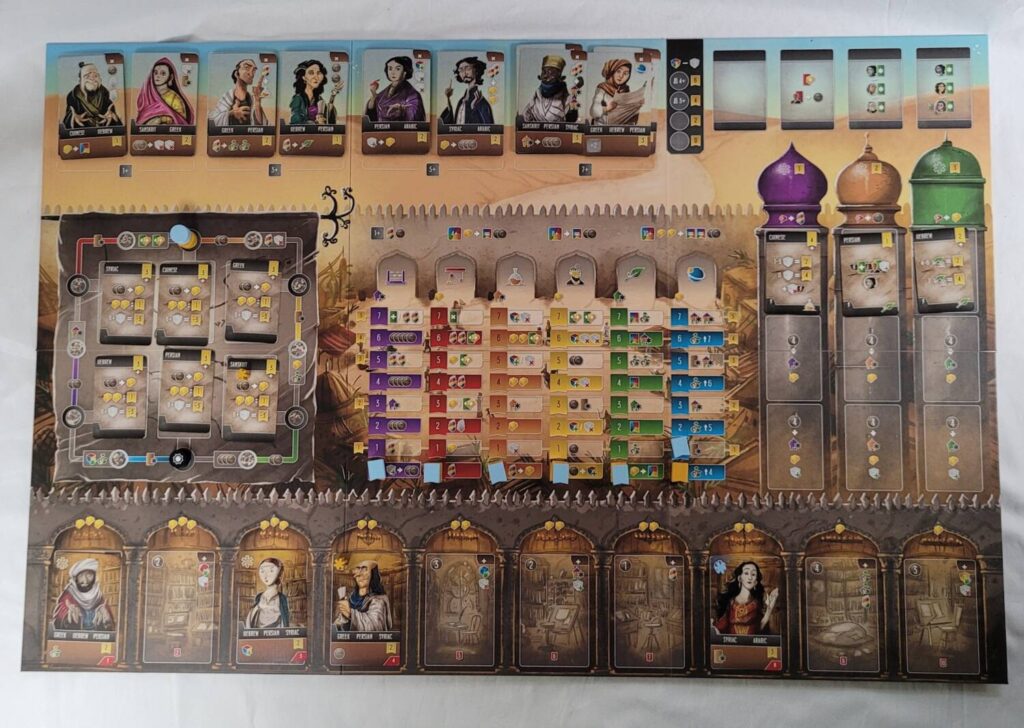
Running along the bottom of the board is an area where activated Translator cards will be placed. Four of the Starting Translator cards will be drawn at random and placed into their specified rooms. A randomly drawn Resource card is placed beneath each of these. We’ll call this the Employed Translator row.
Above this, on the left side of the board, is the map area. This area is filled in with randomly drawn Scroll cards, and the neutral marker is placed into its starting position at the bottom middle of the track that runs alongside the card area. The remaining Scroll cards are mixed together with the Caliph cards in a specific way (according to player count) and the deck is placed face-down close by.
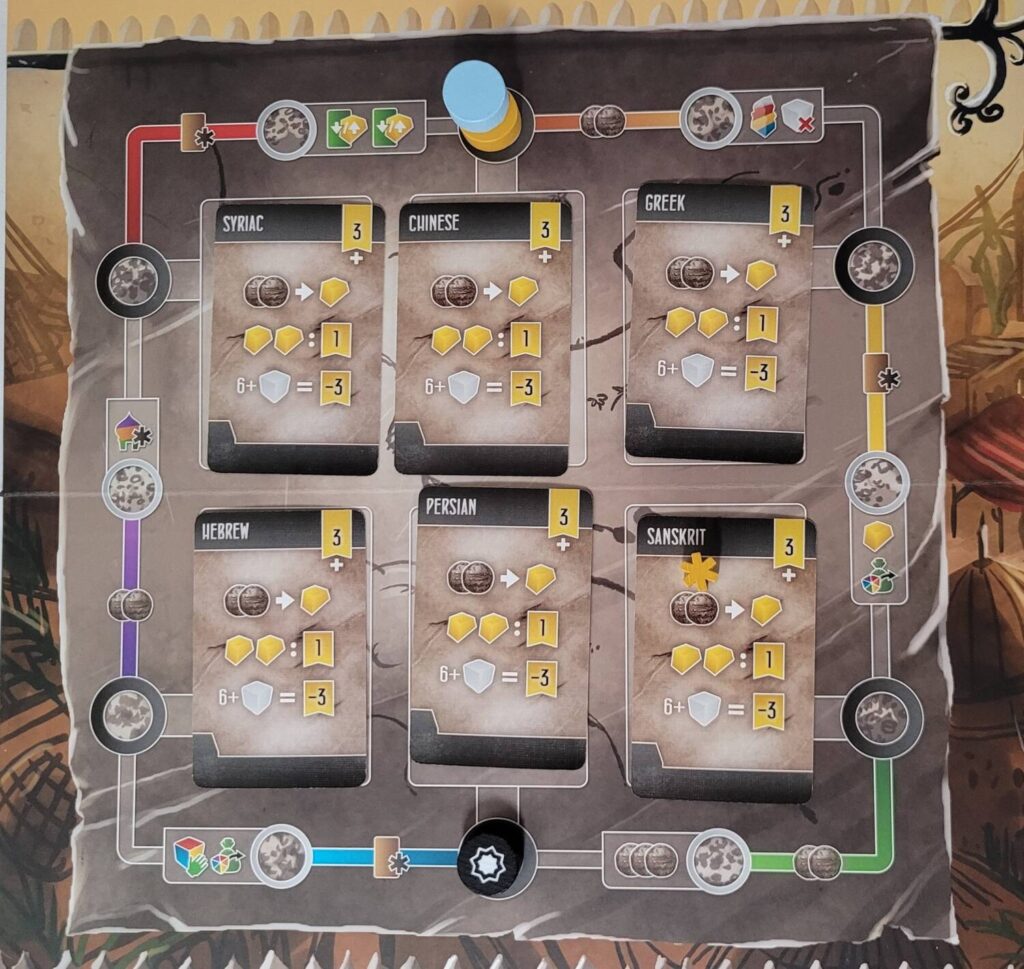
To the right of this, in the center of the board, is the Research area. There are six different tracks here and players will place one of their Research markers on the ‘0’ space of each. In addition to the Research markers, players also receive a Player board, a deck of Influence cards, some Influence markers, a Player marker, and a bag. Players will then draft Starting translators and their paired Resource cards. One of their Influence markers is placed onto their selected Translator and they receive whatever’s printed on the card. They will also receive a Starting Scroll card which lists some goals the player will want to achieve. Each goal provides a specific reward: a worker or an extra die in one of the secondary colors.
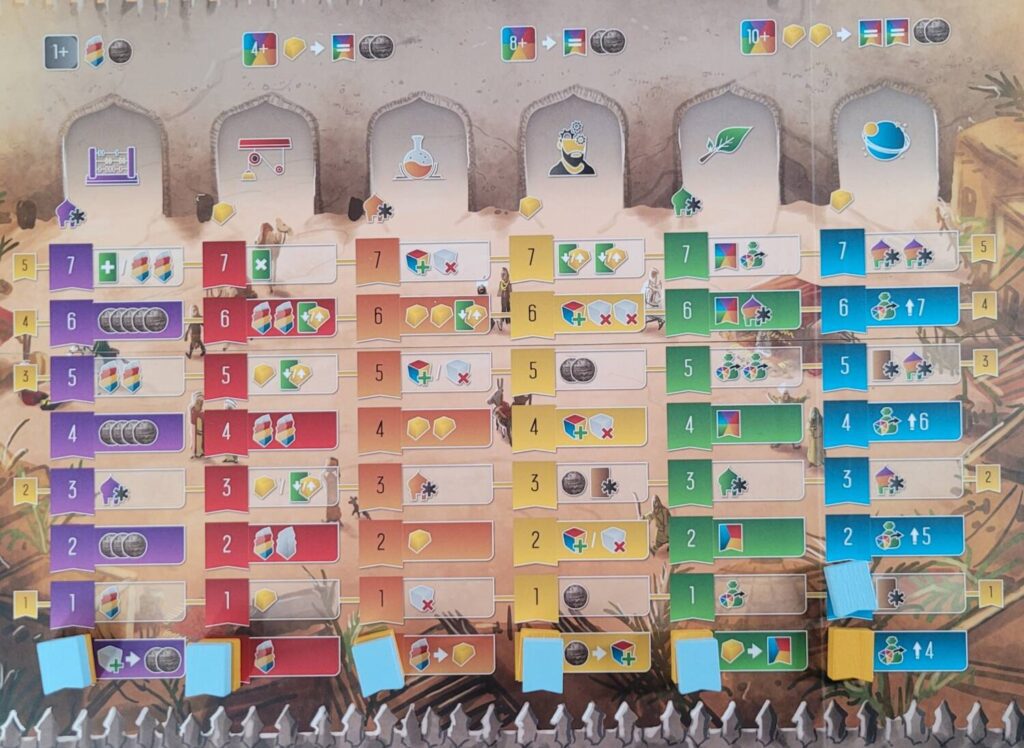
Now, you’re ready to begin playing.
The Dice
At its heart, Scholars is a dice bag building game. So, it’s important to have a general idea of how the dice function within the scope of the game.
On a player’s turn, they are going to play a card from their hand, which provides them with some dice spots, to one of the Action slots available on their Player board. Then they will be assigning dice to that card in order to perform the action associated with their chosen Action slot. In many games, all that would matter here would be the values of the assigned dice. But, Scholars kicks things up a notch. Not only are the values important, but the colors as well.
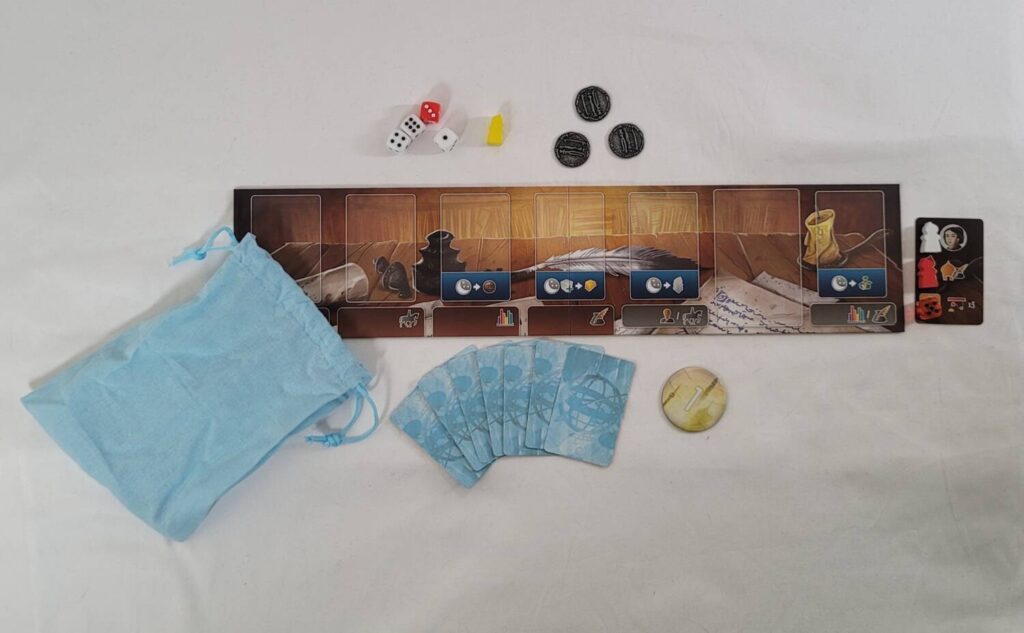
In Scholars, the players begin with mostly white dice. White dice, in general, are weaker because it takes more effort to turn them into colored dice. White dice can be colored into secondary colors by assigning workers to them (a blue worker assigned to a white die turns the die blue, for instance). Secondary colors can be combined to change dice into tertiary colors (blue + yellow = green, as an example). Therefore, if you really need to perform an action using the color orange, but all you have are white dice, you could assign a red worker to one of the dice and a yellow worker to the other. These dice combine to create an orange action with a value equal to the number of pips spread across the two dice.
As you can see, it’s always better to have a colored die at your disposal than a white die. Secondary colors are better than white dice, and tertiary colors are even better than that. Thankfully, you’re not stuck with unwanted dice forever. Just like all good bag builders, there are methods in place to thin out your supply of white dice so that you’ll more consistently draw out the better ones.
How the Game is Played
There are four different actions a player can choose from, some of which are broken down into two sub-actions the player will choose from. The actions, along with a brief overview of each, are:
Recruit (dispatch/employ): The player selects a Translator from the Unemployed Translator row and moves it to the bottom of its deck in order to collect its printed bonuses (dispatching) OR moves it to an empty room in the employed Translator row, paying the silver cost associated with doing so, collecting any bonuses that get covered up by the newly employed Translator, and then placing one of their Influence markers onto it. Which workers you’re able to recruit depends on the overall pip value assigned to the action.
Travel (move and/or deliver): The player moves the Neutral marker around the track an amount of spaces up to the overall value of the pips on the dice assigned to the action. If they end their movement on a white spot, they collect the bonus from the space. If they end on a black spot, they may deliver a Scroll card by paying 4 silver and moving the Scroll card to one of the columns beneath one of the Houses of Wisdom, receiving the bonuses in the space covered by the newly delivered card. A new card is drawn from the Scroll card deck to replace it. If the drawn card is a Caliph card, it is placed into the end game area where it will earn players bonuses. The Caliph cards also function as the game timer. After moving the Caliph card, Scroll cards keep getting revealed, dealing with any Caliph cards that spring up, until an actual Scroll card is revealed. This card is placed into the empty slot.
There are sections of the path in the map area where the travel action takes place that are colored. If the player crosses over one of these sections, and if they used a matching colored die to perform the action, they will also receive the bonus printed on the colored area.
Research (gain resources or move up the research tracks): What the player does depends on the value of the dice assigned to the action, the color of the dice, and how much gold the player spends when taking the action. There are four actions to choose from in total, each providing better benefits than the previous. The more the player assigns to the research action, the better the outcome. For instance, if a player uses a green 4 and spends a gold (a resource which players will earn during the game), they can move up the green track once and collect a couple of silver. But, if they use a green 10 and spend two gold, they move up the green track twice and collect a couple of silver.
Moving up these tracks is important for a few reasons. Firstly, some spaces on the tracks reward you with an immediate bonus as soon you land on them. Secondly, the further you are up on a specific track, the better your income will be when you rest (an action we’ll discuss momentarily). Lastly, the higher up you’ve moved on a track, the more points you’ll earn during end-of-game scoring.
Translate (translate Scroll cards and possibly retire Translators): Translating Scroll cards is the core of Scholars, and the act of doing so is a multi-step process. First, consider the language printed on the card you’re attempting to translate. Then, look at the Translators in the Employed Translators row to see if you can find a path from the language in question to Arabic. Every Translator speaks at least two different languages. Each Translator needed to get from the language on the card to Arabic has a gold placed onto it, and you must pay the owner of each Translator card in this chain, that doesn’t belong to you, a silver.
For example, pretend the card you are wanting to translate is Chinese. Translator #1 speaks Chinese and Greek. You’d have to first place a gold on them. Then you’d find a Translator that spoke Greek and pay them a gold. Let’s pretend this Translator speaks Greek and Persian. You’d need to find a Translator that speaks Persian and Arabic, and pay them gold, to complete the chain.
The newly translated card is placed above your Player board. The card has a type shown in its bottom right corner. Move one step up the Research track of the matching type and collect any bonuses owed for doing so. Then, if there are any immediate effects printed on the translated card, resolve them.
Each Translator occupies a doorway on the Employed Translators row. Each doorway has a number of gold icons printed above it. If a Translator has a number of gold placed onto them equal to the number printed on the doorway, they retire. Retired Translators are slid beneath one of the action spots on your Player board, making that action more powerful in future rounds.
Rest: The player gains income from the Research tracks matching the Action cards they have played. Then, they gather up their used dice, placing them back into their bag, and reclaim their used Action cards. Their turn is now over.
Scoring
At the end of the game, players earn points for the following:
– the dice sum from the black scroll in the end game area of the main board. Players add up their total of colored dice and subtract from this their total of white dice to arrive at their dice sum. The player with the highest sum earns the most points. The player with the second highest earns the second highest amount of points, so on and so forth.
– points from retired Translators
– points from controlling Houses of Wisdom
– points from Caliph cards
– points for final positions on the Research tracks
– points from translated Scroll cards
The player with the highest total wins.
Karlo’s Impressions
Shem Phillips and Sam MacDonald continue to put themselves on the grid by being solid and highly reputable designers of medium minus to medium plus euro games. Scholars is another jump in complexity in comparison to Wayfarers of the South Tigris.
At its core, the mechanisms utilize action selection via cards combined with dice placement with a unique twist. With the aid of meeples, you can utilize color matching to increase dice pip value and you may also change the colors of dice in order to set-up actions. Players will need to eventually “rest” in order to allow these actions to become available again. Resting triggers a ton of income bonuses. A recycled idea from previous designs are seen here with players able to upgrade actions via a card tucking mechanism (seen with the Age of Artisans expansion from Architects of the West Kingdom).
Some observations:
– Clever use of workers and dice allow players to make suboptimal dice rolls a bit more optimal. But, is it really worth it to spend all those resources to change the die? Perhaps you should simply take a sub-optimal action and allow your extra dice and workers to be used later?
– Translation of text in the game forces players to carefully plan ahead of time and hold onto their gold resources in order to optimally translate scrolls. However, translators may retire off of the board if used by players too fast. This dynamic can make it REALLY hard to have players time their translations and can be a bit of an issue with forcing down time at higher player counts since board state constantly changes turn to turn. You can argue that you should hire translators on your own, but you can only do this action maximum twice before you are forced to rest, is this really efficient gameplay on your part?
– The efficiency puzzle of maximizing actions before having to “rest” forces players to really make the most use of their actions while also managing the collection of white colored dice, since such dice can punish players in the end game. Also, the “rest” action progresses the game timer further, so this makes this decision VERY difficult to make The “rest” action serves as a pleasant income phase but still requires very careful planning since all the action cards correspond to some type of bonus off of the income track, which you still gotta push your markers along by taking actions.
– It appears that dice of low pip value (1 through 3) have very little power in the game. It appears (to me) that the designers are suggesting that you quickly upgrade your dice to primary color (red/blue/yellow) or even the more powerful secondary colors (purple/orange/green) which all have 4, 5, or 6 pips on their sides. Players may struggle to find a silver lining on taking small actions with such low pip value and may not find the juice worth the squeeze.
– The game feels incredibly mechanical, there are so many micro-steps you have to take before you fully prepare to translate. And then, once you have a scroll in your possession, an end game bonus is made available to you. This growing tableau of scoring can also make plays long because the decision depth grows deeper as the game advances.
The implicit randomness facilitated by the dice and the ever evolving market of scroll cards and translators may present as a new, pleasant, challenge for some, or may be too dynamic of a system that will frustrate players who are simply trying to weave the mechanisms together.
There are plenty of levers in the game to allow you to mitigate for suboptimal rolls, and there are many options to take actions to seek out any small bonuses you may gain (i.e dismissing a worker, advancing on the income tracks) in order to get the resources, workers, and die you need. Players will either enjoy having this option, or may just find this task a heavy chore.
Ultimately, I don’t think Scholars is going to be a hit for everyone. It has a lot of neat puzzly elements going for it, causing players to really enjoy their efforts in trying to be as efficient as possible with every turn. However, the dynamics of how often the board state changes may easily frustrate players who cannot generate a plan B or even plan C very well.
If you want a Garphill game with dynamic board state with less mechanical overview, I would go for Architects of the West Kingdom.
If you want a dynamic board state but a bit more agency/control over your player actions, I would go for Viscounts of the West Kingdom.
If you want a more sandbox style game with wider decision space and naturally less constraints, I would go for Paladins of the West Kingdom and Wayfarers of the South Tigris.
Amongst a wide catalog of games provided by Garphill, Scholars of the South Tigris is one of the heaviest of the batch thus far, offering familiar euro mechanics with a breath of fresh air with use of color matching and mixing to create stronger actions. The initial breadth of decisions in the early game then narrows down in the mid to late game with very careful planning in how to properly maximize your turns before electing to rest. While decision space is narrowed to 4 specific actions, the ever changing board state may force you to constantly pivot on your turn.
David’s Thoughts
I agree with everything Karlo has already said. Scholars of the South Tigris is one of the finest games that Shem Phillips and Sam MacDonald have produced thus far. The way that dice are ‘colored’ in this game is a mechanism that I have never seen before, and it’s a mechanism I absolutely love. Scholars melts my brain in just the right kind of way. The decisions I am forced to make, while having far-ranging consequences, aren’t too complex. The Starting scroll card I receive during setup provides me with a few clear cut goals to move towards which keeps the game from feeling too sandbox-y. While some games provide you with goals that you can largely ignore, the rewards for achieving your goals in Scholars are sizeable, and completing all of them rewards you with the card itself: an Action card with a pre-printed value 5 white die on it, which gets added to your hand of Action cards.
The game’s pretty much perfect. However, I do have one small gripe. Like many of Garphill Games’s efforts in these past couple of trilogies, Scholars is jam-packed with iconography and could definitely benefit from some robust Player Aids to help the players better navigate these icon-riddled waters. Sadly, though, no such thing is provided in Scholars. Instead, the players are left with having to share the iconography resource printed on the reverse side of the rule book. That’s not such a bad thing if you’re already familiar with the game. But, when you’re playing with newer people that are trying to re-familiarize themselves with the game’s hefty ruleset and all you’re wanting to do is figure out what the Scroll card you’ve been eyeing is trying to tell you… well, it can grow tiresome fairly quickly.
All in all, though, in the pantheon of games in Garphill’s repertoire, Scholars has quickly risen through the ranks for me, and it only rises higher with each and every play. I’ve said it before and I’ll say it again: Shem Phillips and Sam MacDonald have set the bar very high for themselves, and I’m excited to see how they’re able to set it even higher in the future.


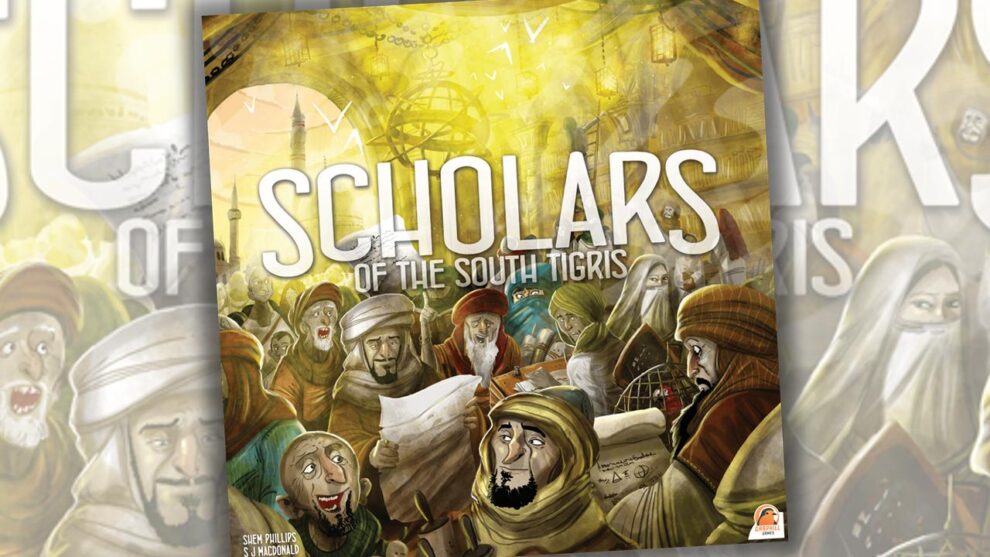






Add Comment